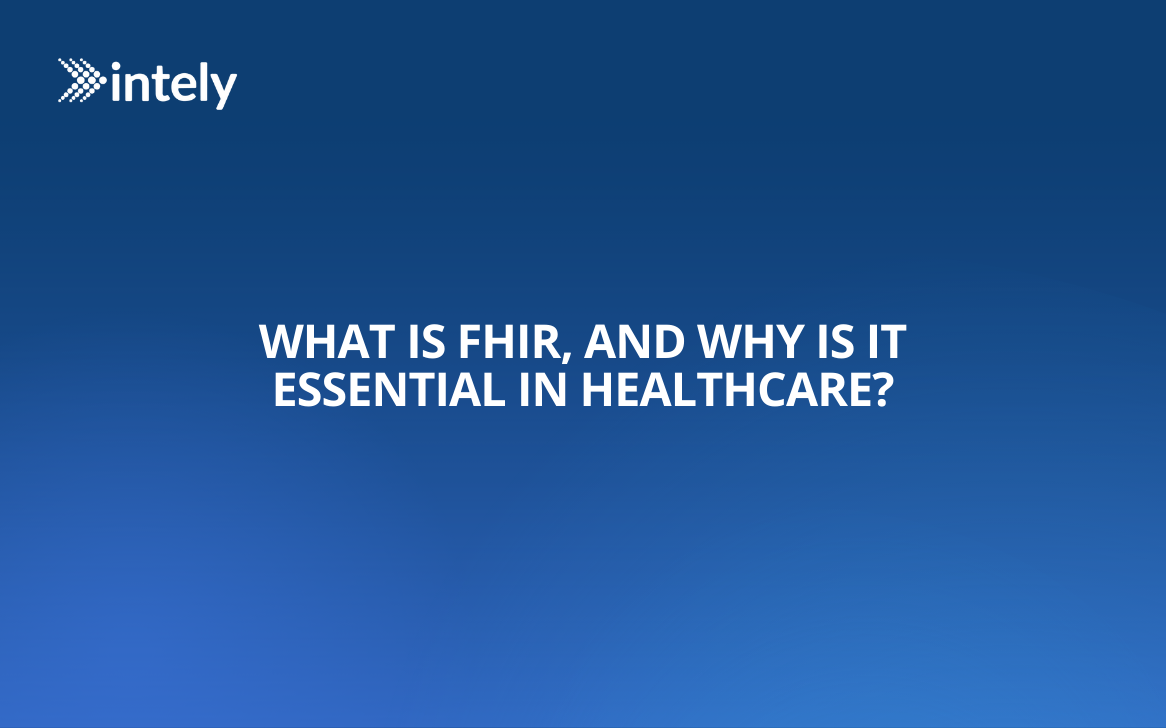What’s New with intely: May Roundup
Here are the highlights of all the content we have posted in the past month. We hope this will give you a sense of what intely is all about, and you'll feel…
Healthcare organizations call FHIR revolutionary because of its ability to change how patient data is shared while reducing costs, making patients more involved…
.png)

Healthcare organizations call FHIR revolutionary because of its ability to change how patient data is shared while reducing costs, making patients more involved in their care, and improving the quality of care. This blog post will answer the golden question -- "What is FHIR?" and explore why it is vital for healthcare networks. We'll look at how FHIR works as well as the benefits of using the new standard.
FHIR is a new standard for healthcare information. It's based on XML, which means different types of software can use it to communicate with each other. For example, FHIR allows you to use an app on your phone to make an appointment at the doctor's office and then download lab results from that visit from the online portal where you can access them.
FHIR stands for Fast Healthcare Interoperability Resources (pronounced as "fire"). FHIR was created by a non-profit called Health Level Seven International (HL7). The goal of HL7 is to develop standards that allow electronic health records systems to communicate with one another so that they work together seamlessly regardless of who makes them or where they're located around the world
FHIR is a new standard for exchanging healthcare information. It can be used by many systems and places, making it easier to work across the healthcare industry. In addition, FHIR allows patients to access their health data using personal electronic devices (such as smartphones) or web browsers. FHIR enables patients to actively manage their care and share information with family members, caregivers, or providers.
FHIR is a RESTful API that allows healthcare providers to exchange information in a standard way. It's based on the HL7 standard and defined by a group of developers and health organizations called Fast Healthcare Interoperability Resources (FHIR).
So, what does this mean? It means that when you're looking at your new patient's medical record on your phone or computer screen, you'll be able to see all their previous lab results from different hospitals with just one quick click. Doctors won't need to visit each hospital and download the data separately.
Fast Healthcare Interoperability Resources have the potential to make healthcare more efficient. It allows for sharing of information between healthcare providers and systems so that patients can have continuous access to their health data. This means you won't have to re-enter your medical history every time you see a new doctor or get tested for an illness.
FHIR can be used for many applications, from monitoring chronic illnesses and managing care plans to sharing information with family members and caregivers about patient progress through recovery, treatment plans, and medication lists. Patients will also benefit from having better control over their records—they can set up alerts when something happens with their care plan.
In a nutshell, Fast Healthcare Interoperability Resources was designed to improve the healthcare industry, which has a long history of using outdated and inefficient systems.
The standard is an open-source set of guidelines that defines a way for providers and other stakeholders to share information consistently. The goal is to make it easier for doctors and patients to access vital data about each other's health records and share information between healthcare providers—allowing them to work together more efficiently.
FHIR can be used across all devices, from smartphones to tablets to medical equipment like MRI scanners or CT scanners.
We know that Fast Healthcare Interoperability Resources can be a little confusing, especially if you're unfamiliar with the healthcare industry. However, it's essential to realize that this technology has the potential to revolutionize health care delivery by improving communication between providers, patients, and insurers.
Hopefully, now you have a better idea of what exactly is involved when implementing FHIR into your practice or hospital's workflow so that you can make an informed decision about whether or not this type of software solution would benefit from investing in it.
FHIR, or Fast Healthcare Interoperability Resources, is a standard for healthcare information exchange. It enables different types of software to communicate with each other using XML, making it possible for applications to share and access health data seamlessly. FHIR was developed by Health Level Seven International (HL7) to ensure that electronic health records systems can work together regardless of the manufacturer or location.
FHIR offers several benefits:
FHIR works as a RESTful API, enabling healthcare providers to exchange information in a standardized way. This API allows seamless access to medical records, lab results, and other health data across different systems. FHIR’s design makes it easy to retrieve data with minimal effort, ensuring that healthcare providers can quickly access and share vital patient information.
FHIR has the potential to transform healthcare by:
FHIR is essential because it modernizes the way healthcare information is shared and accessed. By adopting FHIR, healthcare systems can overcome the limitations of outdated and inefficient data exchange methods. FHIR supports a wide range of devices and applications, ensuring that vital health data is accessible and usable in real-time, ultimately improving patient outcomes and healthcare delivery efficiency.